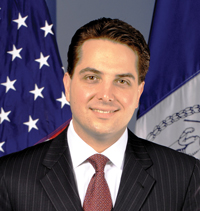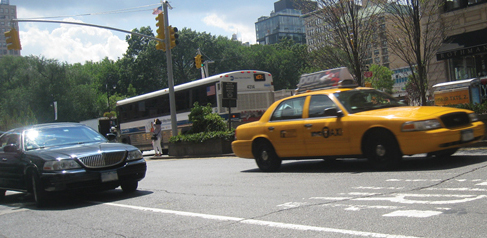 IN FOCUS IN FOCUS |
by Matthew W. Daus, Esq.
President, International Association of Transportation Regulators • Distinguished Lecturer, University Transportation Research Center, Region 2
Contact: mdaus@windelsmarx.com • 156 West 56th Street, New York, NY 10019
T. 212.237.1106 • F. 212.262.1215
|
 |
OVERVIEW OF NEW STREET HAIL LAWS AND PROPOSED TLC RULES
Things are heating up considerably since Governor Cuomo signed a Chapter Amendment in December 2011 authorizing New York City (“NYC”) to issue up to 18,000 street hail vehicle licenses and 450 hail base permits to for-hire base stations.1 In February 2012, very quietly and with no fanfare, revisions were made to the Chapter Amendment that are described below which may have some positive benefits for the industry.2 Also, in March and April, the NYC Taxi & Limousine Commission (“TLC”) will be holding public hearings on new proposed rules designed to implement the new law, highlights of which are described herein.
More Data Points, Enforcement Teeth & Tax Collection
Within two months after the passage of the Street Hail Law, the Governor signed amendments to the original legislation (“2012 amendments”). Of note is the fact that the 2012 amendments increase the amount of information available to the TLC via electronic trip records. “Trip record” is amended to include accounting of hail vehicle and dispatch trips, and “trip data” includes:
(1) the taxicab license number or hail vehicle license number;
(2) any licensed operator’s TLC license number;
(3) hail base permit number;
(4) the taxicab driver’s license number; or
(5) the hail vehicle driver’s license number.3
The goal of enforcement under the law may be better achieved through the collection of this additional information. Also, the 2012 amendments reinforce the revocation provisions under the Law whereby, upon a driver’s third conviction of accepting a passenger by street hail from a location in NYC where street hails by such vehicles are prohibited, the driver’s hail license will be revoked.4
The Chapter Amendment revisions also change the NY State Tax Law making it easier for the State tax commission to monitor and prevent tax evasion by requiring the TLC to furnish records to the tax commission for purposes of monitoring the collection of taxes imposed under the law.5
A Poison Pill – Not a Savings Clause
It should also be noted that the 2012 amendments include an interesting “poison pill” clause which states that should any provision of the law be invalidated by the courts the entire law will fail.6 Usually, laws contain a “savings clause” which provides that should any provisions of the law be invalidated it is the legislature’s intent that the remaining provisions shall survive. Considering that just two days after the passage of the Street Hail Law a Federal District Judge halted the issuance of any permits under the Law until the court approves a TLC plan to address accessibility.7 One wonders why the legislature would make it easier to invalidate the law?
The Livery Passenger Enhancement Program (L-PEP)
Each Street Hail Livery must be affiliated with a base that is specially licensed to affiliate Street Hail Liveries. Drivers and vehicle owners will be required to retrofit their For-Hire Vehicles (“FHVs”) to include a meter for street hails, a roof light, a credit card/debit card reader and a GPS device.
The TLC has termed this new equipment and machinery with its associated media, firmware and other embedded technology the "Street Hail Livery Technology System", or “L-PEP” , the moniker already being used by the industry to classify this Livery program as a replica of the TLC’s "Taxicab Passenger Enhancement Program", "T-PEP" for yellow cabs. Many of these proposed changes mirror the requirements currently in place for yellow taxis, although, at this time, the Commission has not yet picked the color of these new street hail permit vehicles.

Base in “Good Standing” = Pay Your Fines!
The new Street Hail Base Licenses will be made available through three (3) issuances. After an initial one month issuance period for which only Livery Bases in good standing may apply for the 450 Street Hail Livery Base Licenses, the TLC proposes a second issuance period of five months in which Paratransit Bases in good standing may apply for remaining available Street Hail Base Licenses.
Only Livery Bases and Paratransit Bases in “good standing”8 with the TLC for three (3) years will be eligible to apply for Street Hail Base Licenses in the first and second issuance periods. After the Street Hail Livery Base initial and second issuance periods any person or business entity can apply for a Street Hail Livery Base License.
Rather than define “good standing” to include a record with minimum convictions, the TLC appears to allow any bases, irrespective of the severity or extensive nature of its record, to apply for the permit as long as any suspensions are cleared and fines paid. The Street Hail Livery Base Licenses cannot be transferred, and if any owner attempts or otherwise transfers any Street Hail Livery Base the Street Hail Livery Base license will be cancelled.9
A Paratransit “Curve Ball”- Mandatory & Voluntary Permits
The proposed rules contemplate increased involvement of the paratransit industry in the Street Hail Permit program which may have a significant effect on some paratransit base owners “requiring” their participation in the program. This is a natural fit given that paratransit vehicles are accessible and comply with the Americans with Disabilities Act (“ADA”). However, whether the multi-passenger vans frequently used for non-emergency medical transport and their bases can be easily intertwined with the livery industry and accepted by the riding public remains to be seen.
Under the rules, a Paratransit Base which has been issued a Street Hail Livery Base License must affiliate at least five (5) Accessible Street Hail Liveries unless the TLC Chair authorizes a number less than five. Moreover, and of note, if a Paratransit Base has ten (10) or more affiliated Paratransit vehicles then the Paratransit Base must apply for a Street Hail Livery Base License if such licenses are available for issuance, and must affiliate at least five (5) Accessible Street Hail Livery Vehicles (emphasis added). The proposed fine for a Paratransit Base with at least ten (10) affiliated vehicles failing to comply with these new requirements is $10,000 and revocation.
For stakeholders interested in the proposed Street Hail changes the TLC held a public hearing at 9:00 a.m. on March 22, 2012 at the TLC’s public hearing room located at 33 Beaver Street, New York, New York on the 19th Floor.
The TLC is holding a second public hearing on the proposed rules at 9:00 a.m. on April 19, 2012 that will be held at Brooklyn Borough Hall at 209 Joralemon Street, Brooklyn, New York.
The TLC is soliciting comments and testimony from the public for both hearings. Please note that any written comments must be submitted to the Commission by April 9, 2012. Additional information can be found on the TLC website, at www.nyc.gov/tlc.
Windels, Marx Special Counsel, and former TLC Chief Judge Pat Russo, and Associate Jasmine LeVeaux, of the Transportation Practice Group contributed to this article.10
- Senate Bill S5825 available at http://open.nysenate.gov/legislation/bill/S5825-2011; signed as Assembly Bill A8496.
- Assembly Bill A8691A-2011 available at http://open.nysenate.gov/legislation/bill/A8691A-2011.1 {10739449:9}
- See 2012 amendment to Section 13 the Street Hail Law.
- See 2012 amendment to Section 25 of the Street Hail Law. Note, the third conviction must occur within 120 days of the previous two convictions. Under the existing rules, a based owner’s license may be suspended until compliance if an affiliated vehicle picks-up a street hail. See TLC Rule § 59B-25(a).
- See 2012 amendment to Section 21 of the Street Hail Law.
- See 2012 amendment to Section 6 of the Street Hail Law.
- SeeNoel v.TLC,2011WL6747466(S.D.N.Y.Dec.23,2011). 2 {10739449:9}
- “Good standing” is defined under the TLC proposed rules (discussed infra) as a base that
• “(i) [h]as been continuously in operation as a Licensed Livery Base or Paratransit Base for at least three years on the date of Street Hail Livery Base License application and
• (ii) [h]as no outstanding fines, summonses or suspensions as of the date of the application for the Street Hail Livery Base License.” See TLC Proposed Rule § 59B-0.4.1(c)(2)(ii).
- See TLC Proposed Rule § 59B-09(c).
- Disclaimer: These comments are intended to be for information purposes only and should not be taken as legal advice. Prior results do not guarantee a similar outcome.
 IN FOCUS
IN FOCUS
